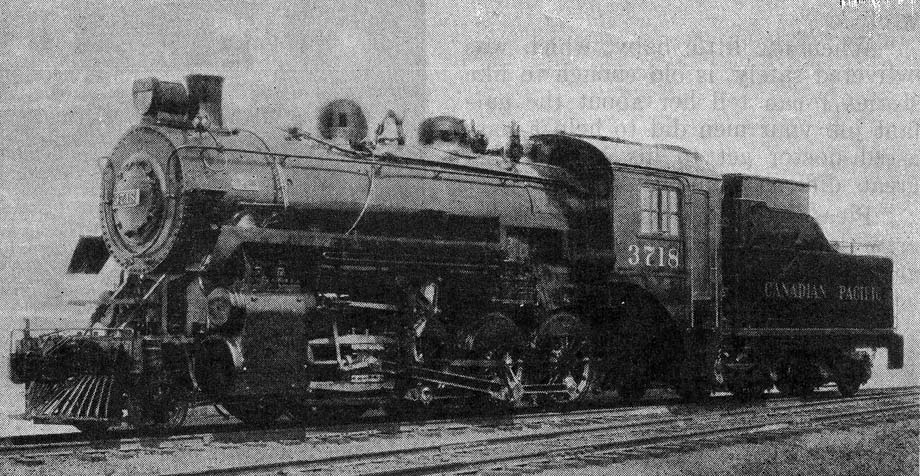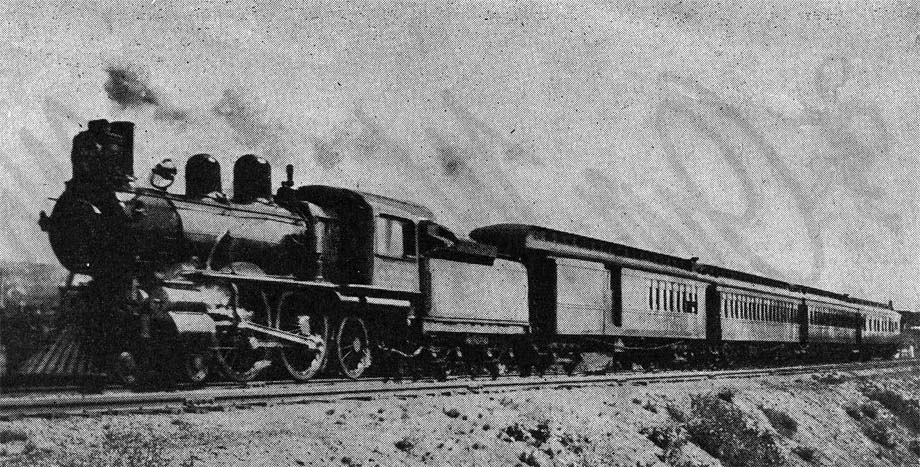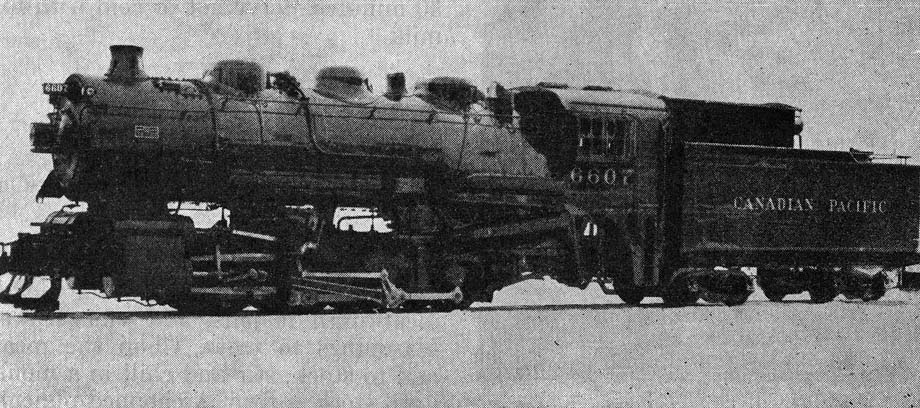
April - 1948
Canadian Pacific Railway
A Study Of Our Motive Power (2 of 3)
By Inventory Classification
By A.E. MIMMS

The first of these, a group of locomotives built in 1897, by the Baldwin Locomotive Works, were of the Vauclain patent, having 13 1/2 inch diameter high pressure cylinders located above 23 inch low pressure cylinders, on each side of engine. The stroke of the pistons was 24 inches, with driving wheels of 62 inches diameter. During the same year, Canadian Pacific shops constructed several classes of cross-compound engines, having a 20 inch high pressure cylinder on one side, and a 30 inch low pressure cylinder on the opposite side. Stroke was 24 inches, and the locomotives were fitted with either 57 or 62 inch driving wheels. The systems of compounding were the Pittsburgh, Richmond, and Schenectady patents.
The last cross-compound locomotives entered the inventory in 1904, when a group of locomotives were purchased from the Saxon Locomotive Works, in Germany.
All of the compound locomotives were at a later date converted to simple locomotives, as the gain in fuel economy by compounding did not compensate for additional maintenance expense. The largest proportion of 4-6-0 group consisted of class D-10 engines. Commencing in 1905, with an order for ten locomotives from Kingston, construction of this class was concluded in December 1913, with an order for 25 class D10h engines from Kingston, comprising in all, a class of over 500 locomotives, of which 329 are still in the inventory. The total number of locomotives of the 4-6-0 type acquired by the Canadian Pacific since 1884 was 971, of which 425 remain in service.
Designed to handle heavy freight service, the 2-8-0 Consolidation type soon appeared on the Canadian Pacific, being introduced in 1884, when eight Baldwin units were acquired upon the absorption of the Toronto Grey & Bruce Railway. These were followed, in 1886, by the purchase of two Baldwin engines, and the construction of three engines in the C.P.R. Shops. The latter had 19 inch x 22 inch cylinders, with 51 inch diameter driving wheels.
Compound Consolidation type locomotives appeared in 1898, with the purchase of fifteen Richmond cross-compound engines, twenty-six Baldwin-Vauclain compounds, and the, construction of eight cross-compounds in Company shops, embodying the Pittsburgh patents. These early cross-compounds were at the time notable locomotives. They were purchased or constructed over a period of twenty-one years, concluding with an order delivered in 1904-1905 from the Canada Foundry Company, Toronto, with cylinders 22 inches and 35 inches diameter by 26 inches stroke, 200 pounds boiler pressure and 57 inch driving wheels. These were class M2f in the C.P.R. classification.
A new design of 2-8-0 type engines was developed by the Canadian Pacific in 1909, when the first N3 class locomotive was built, to be followed in the next five years by 160 additional units of this class. After many years of service, these were rebuilt, with improved cylinders, frames, and valve motion, and re-classified as N2 class engines. At the present time a further conversion programme is underway, which changes the wheel arrangement to 2-8-2 type, provides new boilers, application of trailer truck, stokers, and larger tenders, with a reclassification to class Pln. The most powerful 2-8-0 type locomotive in the inventory is a locomotive acquired from the Algoma Eastern Railway in 1931, having 24 x 30 inch cylinders, 57 inch diameter driving wheels, 200 pounds boiler pressure, and developing 51,500 pounds tractive effort.
The total number of 2-8-0 type locomotives on the Canadian Pacific inventory since the inception of the Company was 546, of which 263 remain in service.
When acquiring the New Brunswick Railway in 1890, the Canadian Pacific received three single-end, Fairlie type locomotives built in 1873 by the Mason Machine Works, Taunton, Massachusetts. The locomotives were one of the earliest types which provided flexibility when passing around curves, by the use of a truck construction for the driving gear. Frames, driving wheels, and cylinders were mounted as a truck, which turned as a unit around a centre pin, flexible jointed steam and exhaust pipes were used.
Records for these particular units are very inadequate, but we know that they had 12 x 16 inch cylinders,
with six driving wheels 36 inches diameter. It is probable that these Canadian Pacific locomotives were equipped
with Walschaert valve motion, as the Mason Works at that time were applying this motion to many locomotives. The
rear truck, located under the tender frame extension, was probably a six wheel truck.

For many years the fastest passenger trains in Europe and the United States were hauled by 4-4-2 Atlantic type locomotives, so called because originally introduced in the service of the Atlantic Coast Line, in 1895. Four years later, in 1899, the Canadian Pacific built three of these locomotives to handle the fast trains then operated between Montreal and Ottawa. As originally built, these were compound locomotives having high pressure cylinders 13 1/2 inches diameter, superimposed above low pressure cylinders 23 inches diameter, stroke 26 inches. Four large driving wheels were 84 inches diameter, 200 pounds boiler pressure was used.
Canadian Pacific experience soon indicated that increased weight of trains could not be properly handled by locomotives of this type, so that no more were built.
The Shay type geared locomotive, built by the Lima Locomotive Works, Lima, Ohio, consists of a locomotive type boiler and tender, mounted upon a continuous frame structure. Upon the right hand side of the boiler is mounted a vertical engine, the crank shaft of which is extended by flexible connections to drive gears upon the axles of the engine trucks, all wheels of which are driving wheels. The advantages of this construction are the proportionately greater tractive effort development, and that the flexibility of the drive permits operation over rough or excessively curved track, where locomotives with rigid driving wheels would encounter difficulty.
Three of these were purchased by the Canadian Pacific in 1900-1901 and 1902. Equipped with a three cylinder
engine having cylinders 15 x 17 inches with driving wheels 41 inches diameter, they were used for service in the
Rocky Mountains, until changing conditions rendered them inadequate to meet the new requirements. By 1914, all
had been scrapped.

Locomotives for switching service built with eight driving wheels, without engine or trailing trucks, have been used for heavy switching or transfer service for many years. Although the first 0-8-0 type engines were built and placed in service by the Canadian Pacific as early as 1906, only twenty-four of these entered the inventory. The last ten were built by the Canadian Locomotive Company, Kingston, Ontario, in 1930-1931 and are classified as V5a. These are powerful modern engines, with 22 x 32 inch cylinders, carry 250 pounds, boiler pressure, have 58 inch diameter driving wheels, and develop 59,400 pounds of tractive effort.
Originating on the Lehigh Valley Railway in 1886, the 4-6-2 or Pacific type locomotive wheel arrangement was not definitely recognized until 1901, when the Baldwin Works built a number of these for the New Zealand Government Railways. In 1902, the Missouri Pacific introduced the type on their line, from which event the type name was derived. The first 4-6-2 type engines on the Canadian Pacific were built in 1906, at Angus Shops, these had 21 x 28 inch cylinders and 75 inch driving wheels. So well adapted were these locomotives to conditions on this railway, that in the years 1906-1947 no less than 498 Pacific type engines were added, of which 435 are still in service. The latest of this type under construction are ten well known G3j class, with 22 x 30 inch cylinders, 275 pounds boiler pressure, having 75 inch diameter drivers, and developing 45,300 pounds tractive effort, also thirty of the G5d class with 20 x 28 inch cylinders, 250 pounds boiler pressure, 70 inch driving wheels, developing 34,000 pounds, tractive effort.
The smaller type has proven very satisfactory both in freight and light passenger service, and has primarily been designed for operation on territory where traffic conditions, or bridge load restrictions limit the use of heavier power.
(To be continued)
 and is reprinted here with their permission. All photographs,
logos, and trademarks are the property of the Canadian Pacific Railway Company.
and is reprinted here with their permission. All photographs,
logos, and trademarks are the property of the Canadian Pacific Railway Company.